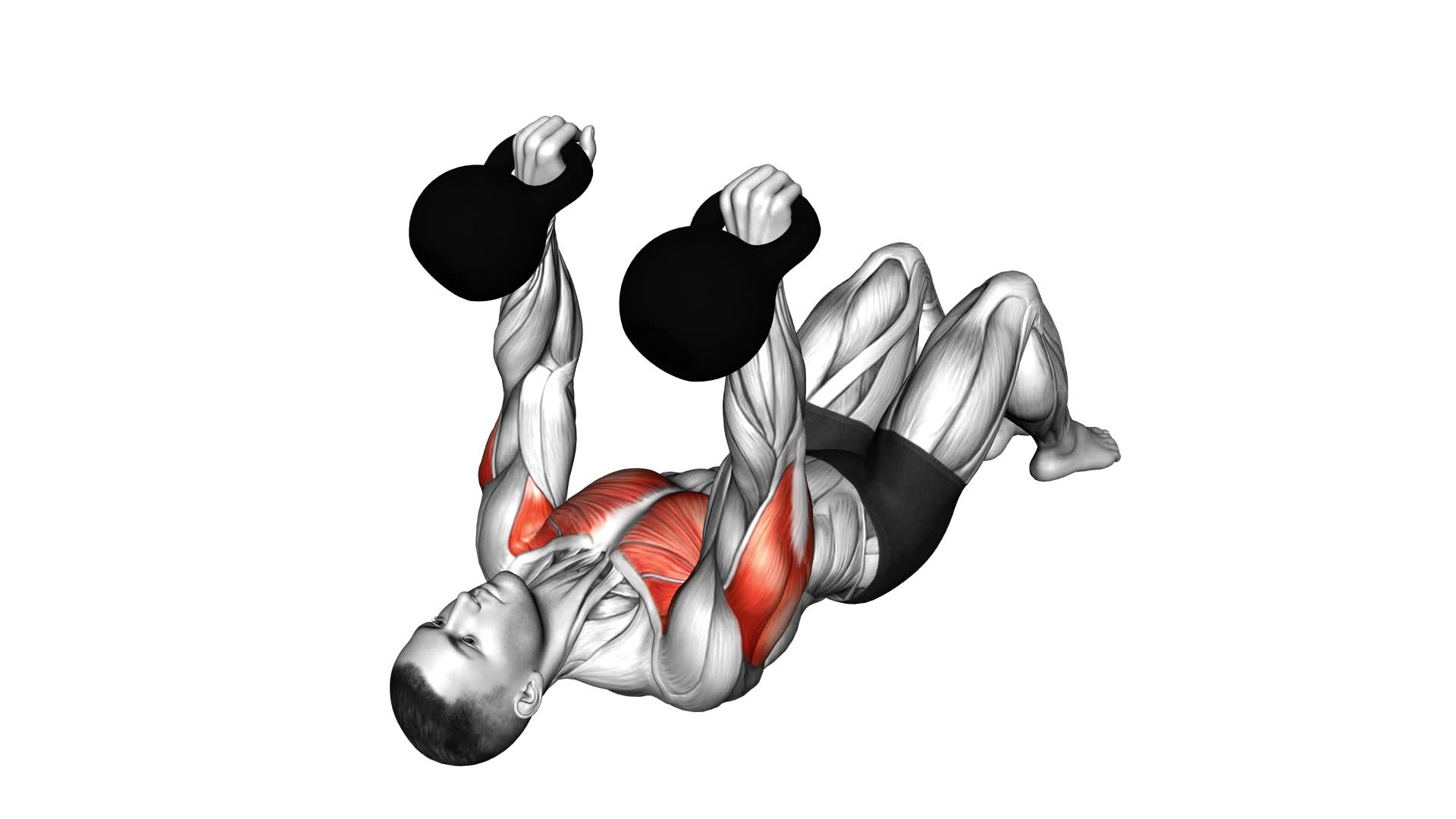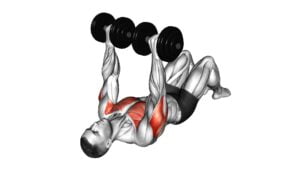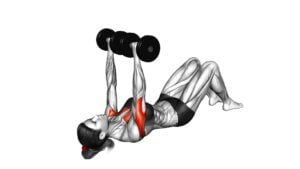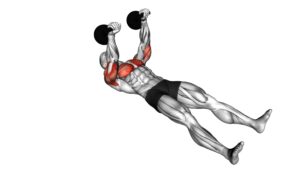Kettlebell Lying on Floor Chest Press – Video Exercise Guide & Tips

Are you looking for a challenging exercise that targets your chest muscles? Look no further than the kettlebell lying on floor chest press.
Watch This Exercise Video
This exercise not only helps strengthen your chest, but also engages your core and stabilizer muscles.
In this article, we will provide you with a step-by-step guide, video demonstrations, and helpful tips to ensure proper form and maximize your results.
Get ready to take your chest workout to the next level with this effective kettlebell exercise.
Key Takeaways
- The Kettlebell Lying on Floor Chest Press effectively targets and strengthens the chest muscles.
- This exercise helps in developing a more defined and toned upper body.
- It improves stability in the upper body, making it beneficial for athletes in sports requiring upper body strength.
- Common mistakes to avoid include using too heavy of a kettlebell, arching your back, allowing elbows to flare out, and rushing through the movement.
Benefits of the Kettlebell Lying on Floor Chest Press
One of the benefits of performing the Kettlebell Lying on Floor Chest Press is that it targets your chest muscles effectively. This exercise is designed to increase strength in your chest, helping you develop a more defined and toned upper body.
By lying on the floor and pressing the kettlebells upward, you engage the pectoral muscles, which are responsible for the movement of your arms across your chest. This motion helps to activate and strengthen the muscles in your chest, leading to improved overall strength.
Additionally, the Kettlebell Lying on Floor Chest Press also helps to improve stability in your upper body. As you press the kettlebells upward, you're required to stabilize your shoulders and core, which helps to enhance your overall balance and control.
This exercise is particularly beneficial for athletes who participate in sports that require upper body strength and stability, such as basketball, tennis, or swimming. By incorporating the Kettlebell Lying on Floor Chest Press into your workout routine, you can effectively target your chest muscles, increase strength, and improve overall stability.
Proper Equipment and Set-up for the Exercise
To properly set up for the Kettlebell Lying on Floor Chest Press, you'll need a kettlebell and a flat surface to lie on. The equipment set up is simple and straightforward. First, choose a kettlebell that suits your strength and fitness level. It's important to select a weight that challenges you but still allows you to maintain proper form throughout the exercise. Once you have your kettlebell, find a flat surface such as a mat or a carpeted floor to lie on. Make sure the surface is free from any objects that may obstruct your movement.
Before starting the exercise, it's crucial to ensure that you have the correct exercise technique. Lie on your back with your knees bent and your feet flat on the floor. Hold the kettlebell with both hands, palms facing towards your feet, and arms extended straight up towards the ceiling. This is your starting position. From here, lower the kettlebell down towards your chest by bending your elbows. Keep your elbows close to your body throughout the movement. Pause briefly when the kettlebell touches your chest, and then push it back up to the starting position by extending your arms. Repeat the movement for the desired number of repetitions.
Step-by-Step Guide to Performing the Kettlebell Lying on Floor Chest Press
To perform the Kettlebell Lying on Floor Chest Press with proper form, there are a few key techniques you need to keep in mind.
First, ensure that your back is flat against the floor and your core is engaged throughout the exercise.
Second, focus on pushing the kettlebell straight up from your chest, keeping your elbows close to your body.
This exercise primarily targets your chest muscles, but it also engages your shoulders and triceps for a complete upper body workout.
Proper Form Techniques
To perform the Kettlebell Lying on Floor Chest Press with proper form, follow these steps:
- Grasp a kettlebell with both hands and lie on your back on the floor.
- Focus on maintaining a stable and engaged core throughout the movement to protect your lower back.
- Keep your feet planted firmly on the ground and press your shoulder blades into the floor for added stability.
- It's crucial to breathe properly during the exercise, exhaling as you press the kettlebell up and inhaling as you lower it down.
Muscle Groups Targeted
Engage your chest, shoulders, and triceps as you perform the Kettlebell Lying on Floor Chest Press. This exercise targets multiple muscle groups, making it an efficient way to strengthen your upper body.
The primary muscle activation occurs in the pectoralis major, or chest muscles, as they contract to push the kettlebell away from your body. Additionally, the anterior deltoids, or front shoulder muscles, and the triceps brachii, located at the back of the upper arm, are also engaged during this exercise.
To modify the intensity of the exercise, you can adjust the weight of the kettlebell or the number of repetitions. Remember to maintain proper form and control throughout the movement to maximize muscle activation and minimize the risk of injury.
Common Mistakes to Avoid During the Exercise
You should always be mindful of common mistakes to avoid during the Kettlebell Lying on Floor Chest Press exercise. To ensure you perform this exercise correctly and effectively, here are some technique tips that can help you avoid these common mistakes:
- Using too heavy of a kettlebell: It's important to start with a manageable weight that allows you to maintain proper form throughout the exercise.
- Arching your back: Keep your back flat against the floor to engage your core and prevent strain on your lower back.
- Allowing your elbows to flare out: Keep your elbows tucked in close to your body as you press the kettlebell up, which helps target your chest muscles more effectively.
- Rushing through the movement: Take your time and focus on the quality of each repetition, ensuring a controlled and steady motion.
- Neglecting to breathe properly: Remember to exhale as you press the kettlebell up and inhale as you lower it back down, maintaining a steady breathing pattern.
By avoiding these common mistakes, you can maximize the benefits of the Kettlebell Lying on Floor Chest Press exercise.
Now, let's move on to some tips to increase intensity and challenge yourself during this exercise.
Tips to Increase Intensity and Challenge Yourself
To increase intensity and challenge yourself during the kettlebell lying on floor chest press, there are a few tips you can follow.
First, try using progressive weight increments by gradually increasing the weight of the kettlebell over time.
Second, vary your tempo and rep ranges to keep your muscles guessing and prevent plateaus.
Lastly, incorporate compound movement variations, such as adding a leg raise or a bridge, to engage more muscle groups and make the exercise more challenging.
Progressive Weight Increments
As you progress in your kettlebell lying on floor chest press, you can challenge yourself by gradually increasing the weight. Progressive weight increments are an effective way to apply the principle of progressive overload, which involves gradually increasing the demands placed on your muscles to stimulate growth and strength gains.
Here are five tips to help you increase intensity and challenge yourself in your kettlebell lying on floor chest press:
- Start with a weight that's challenging but manageable.
- Gradually increase the weight by adding small increments each week.
- Focus on maintaining proper form and technique as you increase the weight.
- Listen to your body and only increase the weight when you feel comfortable and ready.
- Consider working with a certified personal trainer to ensure you're progressing safely and effectively.
Tempo and Rep Variations
To increase the intensity and challenge yourself in the kettlebell lying on floor chest press, incorporate variations in tempo and reps.
Tempo variations involve manipulating the speed at which you perform each repetition. For example, you can try a slow tempo by taking 3-4 seconds to lower the kettlebell to your chest and another 3-4 seconds to press it back up. This slower tempo places more tension on your muscles, increasing the difficulty of the exercise. On the other hand, you can also experiment with a faster tempo to enhance explosiveness and power.
Rep schemes refer to the number of repetitions you perform in each set. You can try different schemes such as pyramid sets (increasing or decreasing reps with each set), drop sets (starting with a heavier weight and decreasing it with each set), or even supersets (alternating between chest press and another exercise).
Compound Movement Variations
To increase the intensity and challenge yourself in the kettlebell lying on floor chest press, you can incorporate compound movement variations. These variations not only provide a greater challenge but also offer several benefits. Here are five compound movement variations to try:
- Single-arm chest press with leg raise: Engages the core muscles while working the chest and arms.
- Alternating chest press with Russian twist: Targets the chest, arms, and obliques for a full-body workout.
- Chest press with bicycle crunch: Combines chest and arm exercises with a core-strengthening bicycle crunch movement.
- Chest press with glute bridge: Activates the glutes and hamstrings while working the chest and arms.
- Chest press with mountain climbers: Incorporates cardiovascular exercise with the chest press movement.
Remember to maintain proper form techniques to maximize the effectiveness of these compound movements.
Modifications and Variations for Different Fitness Levels
For different fitness levels, you can modify and vary the Kettlebell Lying on Floor Chest Press exercise. There are several different exercise options that can be used to adapt this exercise to your specific fitness level.
If you're a beginner or have limited upper body strength, you can start by using a lighter kettlebell or even a dumbbell instead. This will allow you to focus on proper form and technique before progressing to heavier weights.
Another modification for beginners is to perform the exercise without the kettlebell, using only bodyweight resistance. This can help build strength and stability in the chest and shoulder muscles.
For those with injuries or limitations, modifications can also be made to accommodate your specific needs. If you have a shoulder injury, for example, you can perform the exercise with your knees bent and feet flat on the floor instead of extending your legs. This will reduce the strain on the shoulders and still allow you to work the chest muscles effectively.
Additionally, if you have wrist issues, you may choose to use kettlebell handles or push-up bars to keep your wrists in a more neutral position.
Frequently Asked Questions
Can the Kettlebell Lying on Floor Chest Press Help Improve Posture?
Yes, the kettlebell lying on floor chest press can help improve your posture. By incorporating this exercise into your workout routine, you engage your chest, shoulders, and core muscles, which can promote better alignment and posture.
To perform this exercise with proper form and technique, lie on your back with the kettlebell resting on your chest, then press it up towards the ceiling while keeping your core engaged and your shoulders stable.
What Muscles Are Targeted During the Kettlebell Lying on Floor Chest Press Exercise?
During the kettlebell lying on floor chest press, several muscles are targeted. The primary muscles worked include the chest muscles (pectoralis major and minor), triceps, and shoulders. Additionally, this exercise engages the core muscles for stability and balance.
By performing this exercise regularly, you can strengthen your upper body muscles, enhance your pushing power, and improve overall upper body strength.
The kettlebell lying on floor chest press offers a challenging yet effective way to work multiple muscle groups simultaneously.
Is It Necessary to Have a Spotter While Performing the Kettlebell Lying on Floor Chest Press?
When performing the kettlebell lying on floor chest press, it's important to consider if you need a spotter. While a spotter isn't necessary for this exercise, it's always a good idea to have one, especially if you're lifting heavy weights.
Proper form is crucial in kettlebell exercises to avoid injury and maximize results. There are also variations of the chest press exercise using kettlebells that you can explore to target different muscle groups.
How Often Should the Kettlebell Lying on Floor Chest Press Be Incorporated Into a Workout Routine?
Incorporating the kettlebell lying on floor chest press into your workout routine can bring numerous benefits. It's generally recommended to include this exercise 1-2 times per week, allowing ample time for muscle recovery. Regularly including this exercise can help strengthen your chest, shoulders, and triceps while improving core stability and overall upper body strength.
To determine the ideal frequency, consider your overall fitness goals and the intensity level of this exercise.
Can the Kettlebell Lying on Floor Chest Press Be Used as a Substitute for Traditional Bench Press Exercises?
The kettlebell lying on floor chest press can be a great addition to your workout routine. It's a challenging exercise that targets your chest muscles.
But can it be used as a substitute for traditional bench press exercises? Well, the kettlebell lying on floor chest press offers a different range of motion compared to the incline bench press. It also helps improve stability and works your core.
Conclusion
In conclusion, the kettlebell lying on floor chest press is a beneficial exercise for strengthening the chest muscles. By using proper equipment and following a step-by-step guide, you can perform this exercise effectively.
Avoiding common mistakes and incorporating tips to increase intensity will help you challenge yourself and see progress. Additionally, modifications and variations are available to accommodate different fitness levels.
Incorporate this exercise into your fitness routine to enhance upper body strength.

Author
Years ago, the spark of my life’s passion ignited in my mind the moment I stepped into the local gym for the first time. The inaugural bead of perspiration, the initial endeavor, the very first surge of endorphins, and a sense of pride that washed over me post-workout marked the beginning of my deep-seated interest in strength sports, fitness, and sports nutrition. This very curiosity blossomed rapidly into a profound fascination, propelling me to earn a Master’s degree in Physical Education from the Academy of Physical Education in Krakow, followed by a Sports Manager diploma from the Jagiellonian University. My journey of growth led me to gain more specialized qualifications, such as being a certified personal trainer with a focus on sports dietetics, a lifeguard, and an instructor for wellness and corrective gymnastics. Theoretical knowledge paired seamlessly with practical experience, reinforcing my belief that the transformation of individuals under my guidance was also a reflection of my personal growth. This belief holds true even today. Each day, I strive to push the boundaries and explore new realms. These realms gently elevate me to greater heights. The unique combination of passion for my field and the continuous quest for growth fuels my drive to break new ground.







